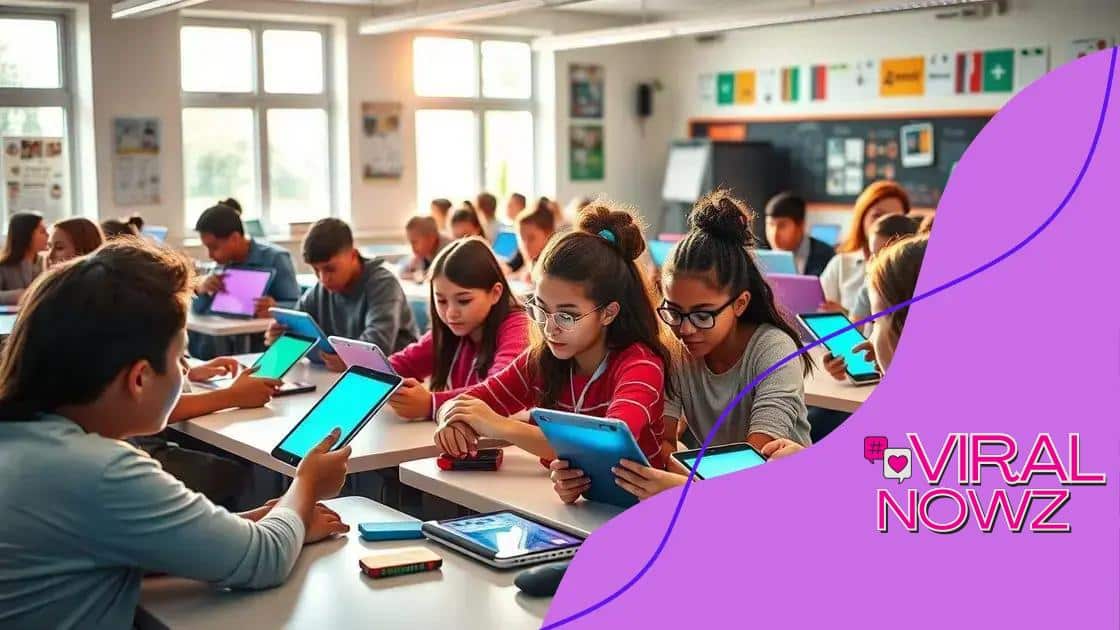Mobile learning platforms for continuous education

Mobile learning platforms for continuous education provide flexible, interactive, and accessible learning experiences, enabling users to enhance their skills anytime and anywhere using their mobile devices.
Mobile learning platforms for continuous education are changing how we acquire knowledge and skills. Have you ever considered how learning on the go could fit into your busy life? Let’s dive into this evolving educational landscape!
The rise of mobile learning platforms
The rise of mobile learning platforms has changed the landscape of education dramatically. Today, learners can access resources anytime, anywhere, making education more flexible than ever.
As technology advances, mobile devices have become essential tools in education. The ability to learn on the go is appealing to many, especially those balancing work and studies. But what factors contribute to this growing trend?
Key Factors Driving Mobile Learning Adoption
There are several reasons why mobile learning platforms are gaining popularity:
- The convenience of learning on mobile devices.
- Access to a diverse range of learning materials.
- The ability to track progress and performance easily.
- Engagement through interactive content.
Moreover, mobile learning platforms cater to different learning styles. Some learners prefer videos, while others benefit from reading or interactive games. This variety ensures that everyone can find a method that resonates with them.
Impact on Continuous Education
The impact of mobile learning on continuous education cannot be overstated. Programs designed for specific skills or certifications are now accessible through apps. This democratizes learning, allowing more people to enhance their skills without geographical limitations.
Examples such as language-learning apps or coding boot camps showcase how effective mobile learning can be. Users engage in short lessons that fit into their daily routine, making skill acquisition less daunting and more enjoyable.
Furthermore, mobile learning fosters a culture of lifelong education. People can pursue new knowledge and adapt amidst rapid changes in various industries. This shift towards ongoing learning helps individuals remain relevant in an ever-evolving job market.
As mobile technology continues to grow, we can expect even more innovative features in these platforms, making learning accessible and exciting. The promise of mobile learning is not just about ease; it’s about transforming lives and careers.
Benefits of mobile learning in continuous education
The benefits of mobile learning in continuous education are extensive and impactful. As education evolves, mobile platforms play a crucial role in making learning more accessible and efficient.
One of the most significant advantages is flexibility. With mobile learning, individuals can study at their own pace and choose when to engage with educational content. This adaptability makes it easier for busy professionals to juggle work and education.
Key Benefits of Mobile Learning
Some key benefits of using mobile learning include:
- Access to a wide range of resources anytime and anywhere.
- Enhanced engagement through interactive learning materials.
- Personalized learning experiences that cater to individual needs.
- Opportunities to learn in real-time, enhancing knowledge retention.
Mobile learning also promotes self-directed education. Learners can control their learning journeys, selecting topics that interest them the most. This sense of ownership often leads to greater motivation and satisfaction.
Improved Skills and Knowledge
As individuals utilize mobile platforms for education, they acquire new skills and stay updated in their fields. Continuous education supports career advancement and personal growth, effectively keeping learners relevant in today’s fast-paced world.
Furthermore, mobile learning tools often come with features that facilitate collaboration. Learners can share insights, access forums, and participate in discussions, which enriches the overall learning experience.
The integration of gamification in mobile learning is another factor that enhances engagement. Incorporating game-like elements motivates learners, making education more enjoyable and effective. Users are more likely to stick with educational apps that provide challenges and rewards.
As we move forward, embracing mobile learning in continuous education will not only transform how we learn but also how we view knowledge and skill acquisition. The potential for growth and development through these platforms is immense.
How to choose the right mobile learning platform

Choosing the right mobile learning platform can significantly impact your educational experience. With many options available, it’s important to consider several factors to ensure you find a platform that meets your needs.
Start by identifying what you want to achieve with mobile learning. Do you need a platform for skill development, certification, or just for personal enrichment? Your goals will guide your decision-making.
Factors to Consider
Here are some key factors to help you choose:
- User Interface: Ensure the platform has a user-friendly design that is easy to navigate.
- Content Variety: Look for platforms that offer a diverse range of courses and materials.
- Compatibility: Check if the platform works well on your mobile device.
- Support and Community: Consider platforms that provide adequate support and have an engaged learning community.
Another important aspect is to look for reviews and testimonials. Hearing from other users can provide valuable insights into the strengths and weaknesses of a platform. Don’t hesitate to explore free trials or demos if available, as they allow you to evaluate a platform’s features before committing.
Assessing Costs
Understanding the cost structure is crucial. Some platforms operate on a subscription basis, while others may charge for individual courses. Look for options that provide good value for the content offered. Always check for hidden fees, as some platforms may add extra costs for certificates or premium content.
Lastly, consider the importance of progress tracking. A good mobile learning platform will allow you to monitor your progress and achievements. This feature helps you stay motivated and allows you to adjust your learning strategies as needed.
As you navigate your options, remember that the right platform will align with your learning style, goals, and needs. With careful consideration, you can find the ideal mobile learning environment for your continuous education journey.
Key features of effective mobile learning tools
Effective mobile learning tools provide several key features that enhance the learning experience. These tools are designed to make education accessible, interactive, and engaging for users of all ages.
One essential feature is interactivity. Engaging learners through quizzes, discussions, and interactive activities keeps them motivated and actively participating in their education. This helps in better retention of information and encourages users to revisit the material.
Essential Features to Look For
When selecting mobile learning tools, consider the following essential features:
- Offline Access: Many learners need access to materials without an internet connection. Offline capabilities make it easier to learn on the go.
- Multimedia Support: Effective tools incorporate various media formats, such as videos, audio, and text, catering to different learning styles.
- Progress Tracking: Features that allow users to monitor their progress and achievements provide motivation and help plan future learning paths.
- User-Friendly Interface: A well-designed interface facilitates ease of use, making it simple for learners to navigate the platform.
Another important feature is customization. Users should have the ability to tailor their learning experience based on their interests and skill levels. This flexibility ensures that learners remain engaged and focused on their goals.
Social Learning Opportunities
Many effective mobile learning tools offer opportunities for social learning. This means creating spaces for learners to interact, share insights, and collaborate with peers. Forums and group activities encourage a sense of community among users, making learning more enjoyable.
Furthermore, gamification elements can enhance engagement. Incorporating challenges, rewards, and leaderboards motivates learners and adds a competitive edge to the educational process. Such elements transform traditional learning into an enjoyable experience.
Lastly, continuous updates and technical support are critical for effective mobile learning tools. Regularly updated content keeps learners informed and ensures they have access to the latest resources. Reliable customer support allows users to resolve issues quickly, thus enhancing their overall learning experience.
Success stories in mobile learning implementation
Success stories in mobile learning implementation demonstrate how organizations and individuals benefit from integrating mobile technologies into their educational practices. These real-world examples highlight the potential for improved learning outcomes and increased accessibility.
Many educational institutions have embraced mobile learning as a way to enhance collaboration among students. For example, a university implemented a mobile platform that allowed students to access course materials, join discussions, and collaborate on projects in real-time. This approach not only increased student engagement but also fostered a sense of community.
Notable Case Studies
Here are some notable success stories:
- A corporate training program: A global company adopted a mobile learning tool for training employees. This resulted in higher retention rates and faster onboarding compared to traditional training methods.
- Language learning apps: Many learners have successfully acquired new languages using mobile apps that use gamification to keep users engaged. Users report higher motivation levels when learning through interactive exercises.
- Non-profit organizations: A non-profit leveraging mobile education reached remote communities. By providing access to crucial training and resources, they empowered marginalized groups to improve their skills and livelihoods.
Another compelling story involves a school district that integrated mobile learning for its students. By providing tablets equipped with educational apps, students were able to access homework, tutorials, and educational games, which significantly improved their performance in subjects like math and science.
Challenges Overcome
While implementing mobile learning, many organizations faced challenges such as budget constraints and device availability. However, by adopting creative solutions, such as partnering with tech companies to subsidize costs, they managed to provide devices to students in need.
Moreover, by focusing on user-friendly designs and ensuring sufficient training for both students and teachers, schools and businesses successfully navigated the transition to mobile learning platforms. As these stories illustrate, with commitment and thoughtful implementation, mobile learning can lead to remarkable transformations in educational outcomes.
FAQ – Frequently Asked Questions about Mobile Learning Platforms
What are mobile learning platforms?
Mobile learning platforms are educational tools that allow users to access learning materials and courses via mobile devices, providing flexibility and accessibility.
How do mobile learning platforms benefit continuous education?
They offer users the ability to learn at their own pace, engage with interactive content, and access resources anytime, anywhere.
What features should I look for in a mobile learning platform?
Key features include user-friendly interfaces, offline access, multimedia support, progress tracking, and community engagement opportunities.
Can mobile learning tools help in professional development?
Yes, mobile learning tools provide targeted training and resources that can enhance skills, improve knowledge retention, and support career growth.





